To achieve the 55% emission reduction target by 2030, there must be at least 30 million zero-emission vehicles on the roads of the European Union. “Unfortunately, this vision is far from reality today,” warned Erik-Marc Huitema, CEO of the European Association of Automobile Manufacturers ACEA.
According to the most conservative estimates of the European Commission, by 2030 there will be three million public charging points for electric vehicles. Therefore, ACEA members are once again calling on EU lawmakers to push national governments to invest in alternative fuel charging and refueling infrastructure.
In addition to infrastructure, other tools are needed to encourage consumers to move towards zero-emission mobility, such as more aggressive carbon pricing, continued fleet renewal schemes, and support measures for skills development and retraining of workers to facilitate the transformation of the sector.
ACEA also notes that the average European car is nearly 11 years old today. Indeed, decarbonization will make new cars more expensive for many Europeans at a time when they have less money to spend due to the economic fallout from COVID-19. This risks not only affecting mobility accessibility, but also leading to an increase in the average age of vehicles, which will slow down fleet renewal.





